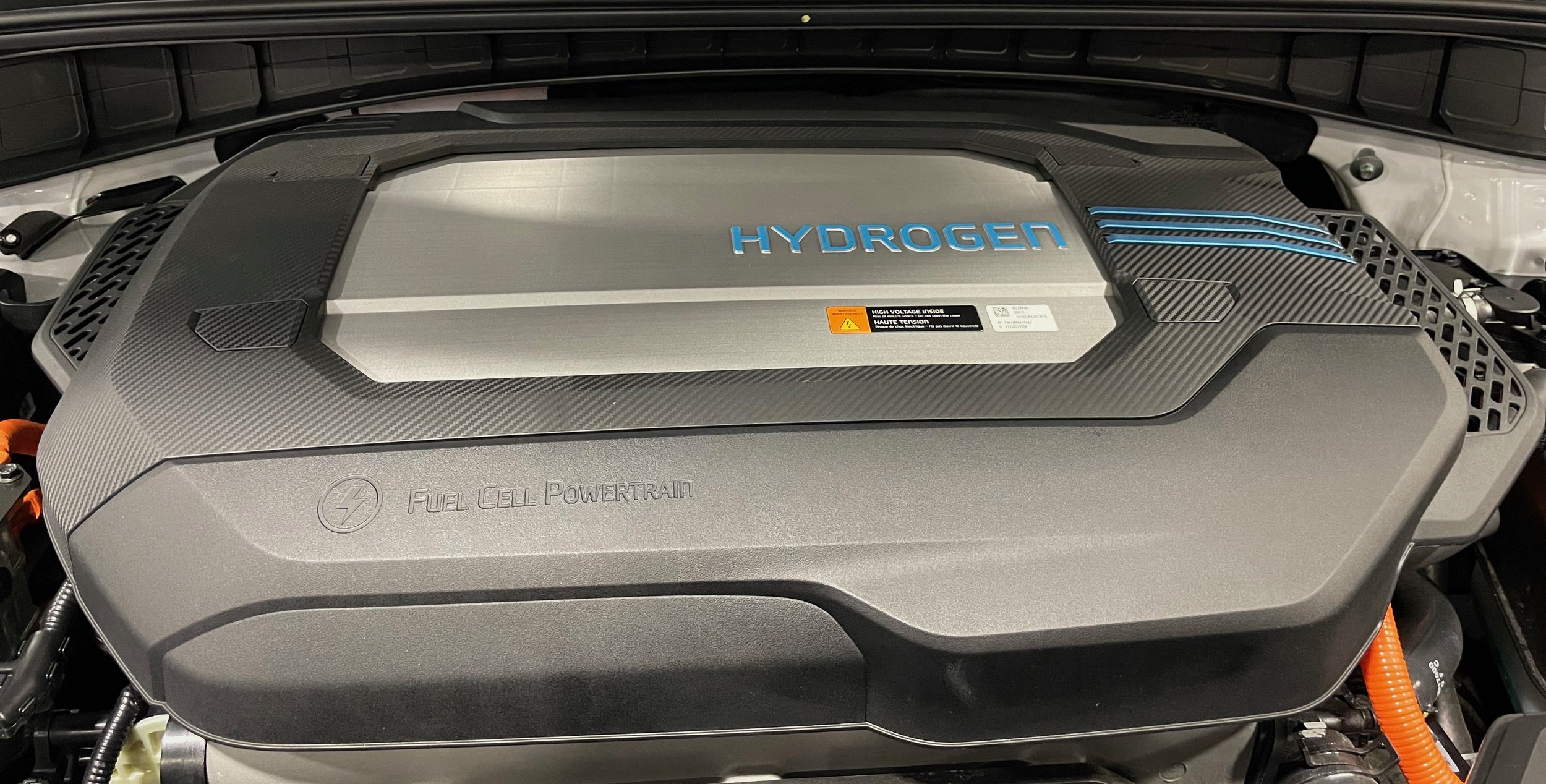Is an EV future sustainable?
Attending the Washington Auto Show on January 27 prompted me to ask several important questions about the future of transportation in the U.S. Among them, what new steps can we take to reduce our dependence on fossil fuels, produce clean energy, and protect the environment? Join me as I explore options including gas-electric hybrids, all electric, and hydrogen fuel cell vehicles. While decades away, fusion energy might be powering our transportation one day.
The electric motor under the hood of Hyundai’s Nexo, its newest hydrogen fuel cell vehicle on display January 27, 2023, at the Washington Auto Show.
Strolling through the Washington Auto Show on January 27, my eyes popped at all the bright and shiny new cars, SUVs and trucks. Also on display were assistive technology wheelchairs and other mobility devices. Vehicles representing 25 brands — from Acura to Volvo — occupied two full floors of the Washington Convention Center.
Electric Vehicle Pavilion at the Washington Auto Show.
Suddenly, a replica of a Chevy Super Sport hubcap came into view, bringing back memories of my ’64 Chevy Super Sport with black leather bucket seats, a radio speaker built into the back seat rest, a chrome-plated inner ring for the horn on the steering wheel, and a huge trunk. What a classy car, fun to drive though it only got 12 miles per gallon (MPG). At 25 cents a gallon in 1973, I could fill it up for about three or four dollars.
Replica of a hubcap from a 1964 Chevy Super Sport Impala, which got about 12 miles per gallon.
Oil Shocks and Sustainability
Those prices were soon gone. Much like today, events in other regions of the world directly or indirectly affected the price at the pump here and fueled inflation. (The 1973 Yom Kippur War and the subsequent oil embargo against nations that supported Israel; the 1978-1979 Iranian Revolution; and Russia’s 2022 invasion of Ukraine.)
Americans began to demand energy independence and policies that could shield us from international events that rippled through our economy in an interdependent world. In the 1970s, the environ-mental movement was gaining momentum as well, leading to the Clean Air Act.
Now, 50 years since that first oil embargo, are we any closer to reaching our energy independence, efficiency and environmental goals?
A 2023 Subaru Solterra EV that I test drove on DC streets out of curiosity. It was a very nice ride. MSRP range from $45K-$52K.
The Toyota I-Road EV, with seating for two. Like a covered motorcycle, it has two wheels in the front, one in the rear.
Toyota-Ottoboch assistive technology wheelchair.
Electric Vehicles (EVs)
Gas/electric hybrid cars have been on the U.S. market since July 2000, when Toyota introduced the Prius to American consumers. In 2023, more cars and trucks are all-electric vehicles, or EVs. With more plug-ins on the road, will we be able to generate enough electricity to power them?
Information from Pricewaterhouse Coopers (PWC) is encouraging. They note that with the Infrastructure Investment and Jobs Act of 2021, the energy and utilities industry has an opportunity to advance its grid modernization and clean energy efforts by tapping into funds allocated in the Infrastructure Investment and Jobs Act.
PWC explains that funds will go to initiatives centered on reducing carbon, including the construction of thousands of miles of new transmission lines needed for the expansion of renewables and clean energy. The funding will also support the development, demonstration and deployment of cutting-edge clean energy technologies to speed the industry’s transition to a (hoped-for) zero-emission economy.
What sources do power companies or co-operatives use to generate electricity?
A U.S. Energy Information Administration report from November 2022 tells us that in 2021:
— 61% of electricity generation was from fossil fuels: coal, natural gas, petroleum, and other gases.
— 19% was from nuclear energy, and about
— 20% was from renewable energy sources (wind, solar, geothermal, hydroelectric)
The EIA estimates that an additional 49 billion kWh of electricity generation was from small-scale solar photovoltaic systems in 2021.
More than half of new U.S. electric-generating capacity in 2023 will be solar.
U.S. electricity sources in 2021. Data: U.S. Dept. of Energy
EVs in Mass Transit
A clean, zero-emissions all-electric Metrobus.
Goodbye diesel buses!
I spoke with several people from Washington DC’s Metro at the auto show. Metrobus is transitioning to a 100% zero-emission bus fleet by 2045, replacing its entire fleet of 1,500 buses. The first 12 are expected to be in use by the end of 2023. Over time, this will improve regional air quality, reduce greenhouse gas emissions, and provide customers with a quieter, comfier ride.
“A phased approach will provide time for electric and other zero-emission technology (such as hydrogen fuel cells) to improve and provide consistent reliability on par with conventional buses, enabling Metro to continue providing the level of service required to meet our region’s mobility needs,” the agency says.
Same model bus Rosa Parks rode in Montgomery AL.
In 2005, Metro dedicated a 1957 historic Metrobus to the life and legacy of Rosa Parks as part of a national tribute to the icon whose refusal to give up her seat to a white man on a Montgomery, AL, city bus, added momentum to the civil rights movement.
Local graphics artist Josue Martinez, owner of Corinto Gallery at National Harbor, Md., decorates a Toyota donated by the Art of Motion program.
Art of Motion donated cars for local artists to decorate.
Toyota’s Trailhunter truck features a pop-up tent on the rear frame for all-in-one camping convenience.
A boy takes a virtual test drive in an EV6 GT at the Washington Auto Show.
Are EVs economical?
According to Kelly Blue Book and the Environmental Protection Agency (EPA), Tesla’s standard batteries will run for about 272 miles, and their long-range batteries will provide up to 405 miles. Mileage range for other brands such as Chevrolet, Hyundai, and Lucid yield from the 250s up to 500 miles per full charge. For the models studied, estimates for the annual electricity cost is about $500 for 15,000-miles per year.
Is it easy to find a charging station, and how many are there in the U.S.?
A company named Forth, located in Portland, Oregon, can help answer that question. It specializes in electrify transportation by bringing people together to create solutions that reduce pollution and barriers to access. Forth has built strong partnerships and networks within industry, including utility companies, government and nonprofit sectors to align community needs with service.
According to their website, there are over 47,000 public charging stations and more than 123,000 EV charging ports in the U.S. One can see these numbers increase every week at shopping centers, “gas stations,” and in driveways or parking lots.
There are three types of chargers:
Level 1 – 120V outlet, full charge in 8 hours, best for home/overnight charging.
Level 2 - 240V outlet, full charge in 4 hours, ideal for home, work, or on the road
Level 3 - Direct current (fast charging), full charge in 20 minutes, public charging stations.
The Alternative Fuels Data Center at the U.S. Department of Energy has a wealth of information on EV charging as well.
Is the EV revolution sustainable?
A Congressional Research Service (CRS) report published in August 2022 acknowledges that “Expected growth of EV sales has led to concern about securing mineral inputs used in EV batteries.” Further, the report states, “the potential for an accelerating global transition to EVs leads some to question the domestic availability of the minerals and materials for the domestic manufacture of EV batteries.”
EV batteries depend on five critical minerals whose domestic supply is potentially at risk for disruption: lithium, cobalt, manganese, nickel, and graphite. The U.S. Geological Survey designated these and other minerals as “critical,” according to the methodology codified in the Energy Act of 2020.
Given this demand, will we have a continuous supply of these raw materials to manufacture EV batteries? Is our power grid able to handle the demand for electricity, and where will the electricity come from?
The CRS report indicates that “the United States is heavily dependent on imports for these minerals for use in EV batteries and other applications. The United States currently mines some lithium, cobalt, and nickel, but it does not currently mine any manganese or graphite. Various companies have indicated plans to expand the mineral production of these minerals.
”Recycling products containing these minerals contributes to some domestic production, and it represents further potential contributions to domestic supply. Additional research to increase EV battery efficiencies or research into new battery chemistries can reduce the requirements of these critical minerals for EV battery production.”
Other analysts agree that there could be a shortage of some of these critical minerals because EVs are here to stay. “Research and development at various companies is significantly improving the performance of electric vehicle batteries by reducing the cost of production, increasing their power, and improving their range,” wrote analyst Blaise Manga Enuh, PhD in a November 2022 AZO editorial “Making recyclable battery cells could help significantly to reduce the pressures on mines.”
Hydrogen Fuel Cells in Transportation
Hyundai was the only manufacturer at the auto show to exhibit a hydrogen fuel cell vehicle on the floor -- the Hyundai Nexo.
Electric motor under the hood of Hyundai’s Nexo, powered by a hydrogen fuel cell.
Background: For a brief period (1993-2002), the U.S. government and the automotive industry funded a hydrogen fuel cell research program, known as the Partnership for a New Generation of Vehicles (PNGV). In 2002, coordination of the research was transferred from the Commerce Department to the U.S. Department of Energy as the Freedom CAR (for Cooperative Automotive Research) aimed at speeding development of pollution-free vehicles powered by hydrogen fuel cells. Over time, however, budgets for the program moved away from funding vehicular hydrogen fuel cells to technologies with more immediate promise such as plug-in EVs.
Hyundai’s NEXO fuel cell SUV.
Info center of Hyundai’s Nexo Fuel Cell car.
How does a hydrogen fuel cell work? The Hyundai website describes it this way:
Fuel cells combine hydrogen fuel with oxygen taken from the air to produce electricity, heat and water. Without combustion, there are no harmful emissions with the only by-product being water. The fuel cell works by passing hydrogen and air through a fuel cell stack. Electricity is created through a chemical reaction within the stack powering the vehicle and emitting nothing but water vapour.”
California is the only state with hydrogen fuel cell refueling infrastructure to support the nearly 15,000 fuel cell cars. According to the state’s Hydrogen Fuel Cell Partnership, there were 55 hydrogen refueling stations, and 66 fuel cell busses by the end of 2022. More than 100 more refueling stations are under development.
According to the partnership, fuel cell electric cars typically can travel 300 miles or more on a full tank of hydrogen, with the ability to refuel in 3 to 5 minutes. Hydrogen fueling is no more complicated or time-consuming than filling a standard car with gas.
Our Power Grid
There is strong demand for hybrid EVs and all electric EVs. According to Samantha Houston, Senior Vehicles Analyst at the Union of Concerned Scientists, “the grid is well-equipped to supply energy to EVs at current adoption levels. Over 2.7 million plug-in hybrid and full battery-electric cars and light trucks were sold in the United States by the end of 2021, with the majority of those still on the road.”
Since today’s cars are more durable than in the past, the transition to 100% electric vehicles between now and 2035 will be gradual in order to meet state and federal greenhouse gas reduction goals for 2050. And in that case, we should get close to 100% on-road electric cars by 2050.
In the end, she notes, we need grid operators to update their approach to grid management to be more dynamic to match an increasingly dynamic energy supply and demand paradigm. By adding renewable energy sources such as wind, solar, geothermal and nuclear to power the grid, a 100% renewable electricity grid can accommodate a highly electrified future.
Fusion Ignition
On Dec. 13, 2022, the U.S. Department of Energy (DOE) and DOE’s National Nuclear Security Administration (NNSA) announced the achievement of fusion ignition at Lawrence Livermore National Laboratory (LLNL)—a major scientific breakthrough decades in the making that will pave the way for advancements in national defense and the future of clean power. On December 5, a team at LLNL’s National Ignition Facility (NIF) conducted the first controlled fusion experiment in history to reach this milestone, also known as scientific energy breakeven, meaning it produced more energy from fusion than the laser energy used to drive it. This historic, first-of-its kind achievement will provide unprecedented capability to support NNSA’s Stockpile Stewardship Program and will provide invaluable insights into the prospects of clean fusion energy, which would be a game-changer for efforts to achieve President Biden’s goal of a net-zero carbon economy.
The Takeaway
The transition to an EV future and other power sources for cars and trucks is underway. Rather than make any recommendations, this blog provides information on resources you might want to research further if and when you are considering purchasing a car or truck. Or take the train and one of the new EV Metro buses!

















